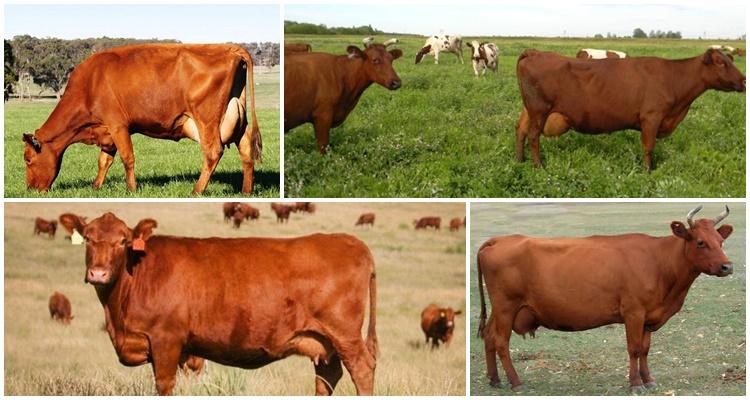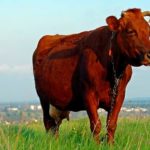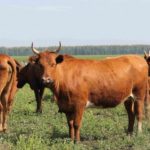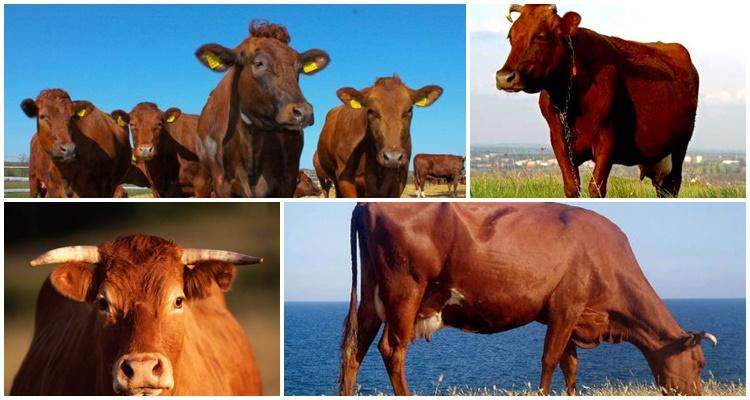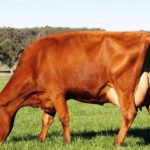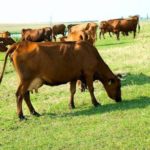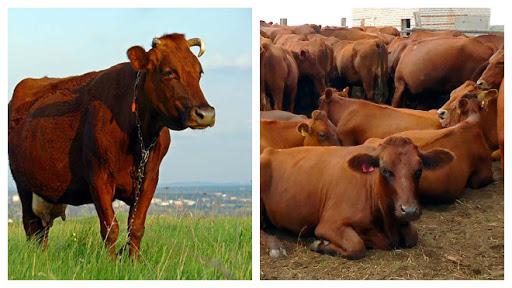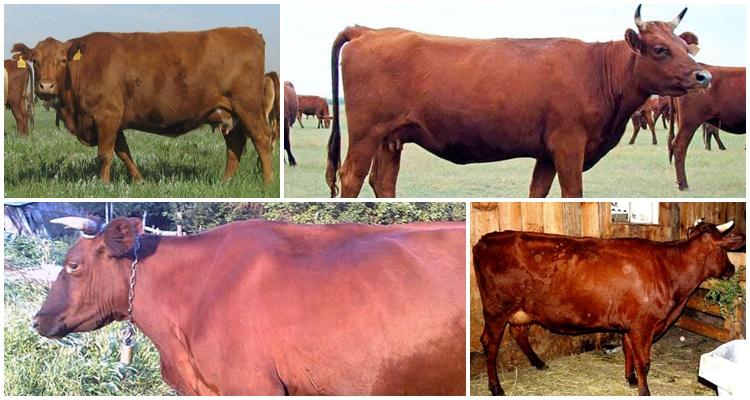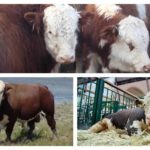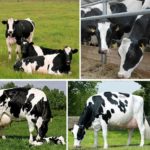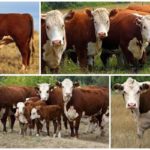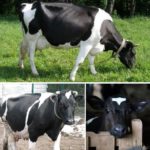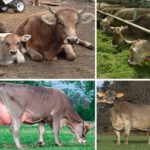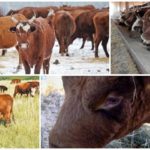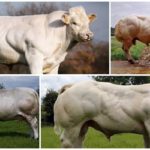The Red Steppe breed is very different from other types of cows. Animals endure the unbearable heat of the southern sun, go without water for a long time and, if necessary, are content with meager food. Nurseries are well known as producers of high-quality milk. Cows are known for their mobility. The milk yield of cows depends on the regularity of walks.
Breeding history
The history of the appearance of an unusual breed of cows dates back 3 centuries.The steppe part of sunny Ukraine became the homeland of cows. In those distant times, German settlers lived on the territory of the city of Melitopol. Zealous colonists crossed local steppe cows with representatives of the Simmental, Wilstermarsh, East Friesian, Red Danish and Angler breeds.
Livestock breeders specially selected dairy animals for crossing. All cows were similar in genetic qualities and metabolism. If previously local cows were mainly used as draft power, now the situation has changed. A red, steppe breed of animals was born. Milk cows are distinguished by their rare unpretentiousness in diet and living conditions. They instantly adapt to any climate and rarely get sick. A few years later, the red steppe beauty received official recognition. Cows could be found on farms located in Western Siberia, the Volga region, Kuban and the Stavropol Territory.
Today, animals have become widespread in Kazakhstan, Russia, Moldova and the Caucasus. During the Soviet era, red cows were bred everywhere. In some parts of the country, the number of red steppe pets accounted for 80-90% of the total number of cattle.
Detailed description and characteristics of red steppe cows
The unique qualities of the breed are not limited to the animals’ ability to adapt to any climatic conditions. Cows are able to go without water for a long time and survive drought without loss. With good care, animals produce 4-4.5 tons of milk per year. The fat content of the product is 3.7%.
Characteristics of cows:
- The chest of cows is not wide, but deep. The animal's chest circumference reaches 185-190 cm. On average, the pet grows to 127-132 cm.
- The animal's skeleton is graceful and light.The muscles are poorly developed.
- The weight of adult sires easily reaches 800-900 kg. Females weigh less - from 450 to 560 kg. Healthy calves gain weight well, and by the age of six months, bull calves gain 150-170 kg.
- A well-developed lower back, powerful legs and a straight, strong back indicate the origin of the animals. Their ancestors were used as draft animals to transport salt.
- The length of the animal’s elongated body reaches 165 cm.
- The angularity of the outlines of the pet’s body is compensated by the beautiful lines of the dry neck.
- The small elongated head of the cow is crowned with a pair of sharp horns. They are directed forward and are a formidable weapon for people and animals. Because of this feature, pets' horns are removed.
- The skin has an elastic, smooth structure. It does not sag on the animal even with severe weight loss. Red steppe cows often lose weight for various reasons; even changes in weather affect the condition of the animals.
- The pet's udder reaches medium size. It has the shape of a round bowl and is unevenly developed. When filled with milk, the organ swells greatly. After the milking procedure, the udder sharply decreases in size, and its surface gathers into folds.
- The skin of a cow is colored red, brownish or reddish cherry. Some individuals are marked with white spots on the chest, head or udder.
- Under the animal's neck there are folds of skin.
Positive and negative sides
The Red Steppe cow has a lot of advantages and is simply created for dairy farming. However, for successful breeding and production of dairy products, it is necessary to take into account the disadvantages of the breed.
Is it possible to release the red steppe for slaughter?
The red steppe cow is a dairy cattle, but in some cases the animal is sent for meat. This use of animals can hardly be called profitable, because the net yield of the product is only 50%. However, the taste of meat is highly valued.
Subtleties of content
Representatives of the Red Steppe breed do not tolerate being kept on a leash. Animals need constant movement indoors and outdoors. Physical activity of cows will help avoid postpartum complications and udder swelling.Keeping pets loose helps increase milk yield and milk fat content.
Basic care
Basic care for red steppe animals does not require much effort. In winter, cows are kept in a warm, dry room. For normal well-being of pets, it is necessary to maintain an air temperature of +12-22 degrees. The barn is equipped with natural or artificial ventilation. The room must be illuminated. Windows should occupy 15-20% of the wall area.
In winter, the floor in the stall is covered with an impressive layer of bedding. Periodically it is covered with a fresh portion of hay. In the barn, pets are kept in a common herd or individually. In group keeping stud bulls separated from their relatives and sent to personal apartments.
If a large number of calves are born, the young animals are divided into age groups. The senior category of bulls corresponds to an age of 1.5 to 2 years. The average age category is from 1 to 1.5 years, the youngest is from 6 to 9 months.
For babies, they make a permanent warm bedding consisting of sawdust and straw. This pillow is treated with a drug to suppress the growth of pathogenic organisms. The product prevents straw from rotting. Already 3 weeks after birth, calves need active movement, so a special walking area is equipped for them. Calves are regularly washed and thoroughly combed, thus ridding them of parasitic insects.
Before each milking procedure, the cow's udder is carefully washed. Animals are regularly treated with drugs to prevent diseases caused by intestinal and pulmonary parasites, and drugs are also used against gadfly larvae and ticks.
Dead period
Deadwood is a temporary period when a cow stops milking.Depending on the physical condition of the animal, the “vacation” lasts from 50 to 70 days. The pet needs such rest, because she spends a lot of energy on bearing and feeding her offspring. Otherwise, the cow’s health will be undermined. The dry period cannot be shortened. Lack of rest leads to poor milk quality, barrenness, or the birth of a non-viable calf.
Breeding
Red steppe cows mature quickly, so at the age of 16-19 months the cow is inseminated. For breeding, healthy individuals are selected that do not have obvious external defects. During pregnancy, the cow is fed and watered 3 times a day. It is forbidden to give the cow cold and poor quality food. Representatives of the breed rarely experience difficulties with labor.
The newborn calf is cleaned of mucus, rubbed with a piece of soft cloth and returned to the mother.
In the first hours of life, the baby feeds on maternal colostrum. The animal is fed at least 5 times every 24 hours. After a day, the calf is given warm water. The permissible daily water intake for a baby is 3 liters. After 14 days, the calf begins to be introduced to solid food. The best complementary food for an animal is hay brewed with boiling water. Before use, the food is infused for 6-7 hours.
The health of a newborn calf depends on hygiene. Excrement must be removed immediately and the dishes must be treated with boiling water. After a successful calving, the horned beauty is provided with clean bedding and plenty of water. The animal’s diet includes all the necessary vitamins, proteins and microelements. The cow is taken for a walk every day. An animal needs exercise at any time of the year.
Nutrition
In the summer, cows obtain food on pasture. If there is not enough grass for the animals, the cows are supplemented with vegetables and concentrates.
Diseases
Animals of the Red Steppe breed are famous for their strong immunity, but in some cases it is not possible to avoid the disease. In these cases, it is important to promptly diagnose a dangerous disease and begin treatment.
Pets are affected by:
- Leptospirosis. A dangerous infectious disease threatens the animal with death. The infection affects the mucous membranes and internal organs of the cow.
- Demodecosis. The culprit of the disease is a tick. The disease manifests itself in the form of small tubercles covering the area of the cow's head, neck and back.
- Poisoning. Trouble occurs as a result of an animal eating poisonous plants.
What do you need to know when purchasing?
When purchasing a calf, you need to obtain information about the weight of the young animal. The pet's weight must correspond to the age norm. At 6 months, the bull weighs from 120 to 145 kg. The heifer gains up to 90 kg. The animal must be energetic and active. When purchasing an adult cow, pay attention to the udder. There should be no deformation or hardening on it.

